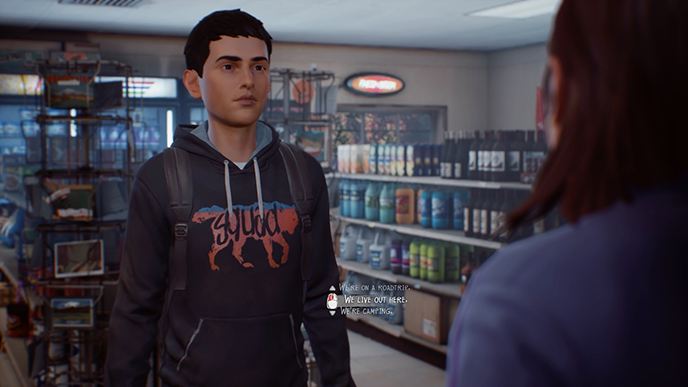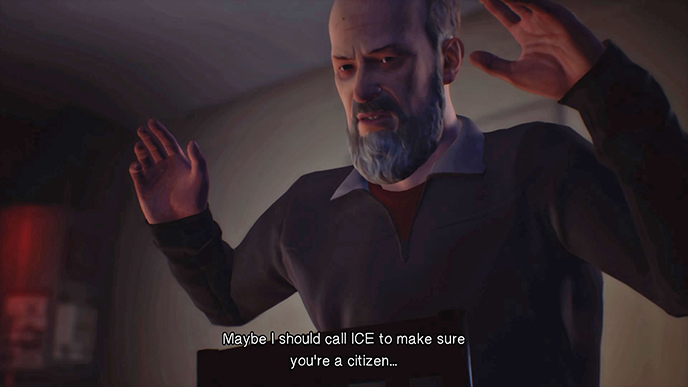What Other Games Can Learn From the Racism in Life is Strange 2

We’ve all seen them: viral Twitter videos of bigots saying and doing Very Racist Shit to Latinx people. They seem like caricatures of a past generation, but really, the sentiments these people espouse never really went away; they’ve simply been unveiled and amplified since the 2016 presidential election. It’s why, when a bigot in Life is Strange 2 told the protagonist—Sean Diaz, a Latino-American—that “thugs” like him are why “we need to build that wall,” it didn’t seem as unrealistic to me as it does to some non-Latinx people. It reflects how some people actually speak and think. Life is Strange 2 excels at showing how racism manifests in different ways—and how the unabashed bigot isn’t racism’s only form, making for one of the most nuanced takes on the subject in videogames.
The first episode of Life is Strange 2 doesn’t wait for one of its characters to openly state that “everything is political” for it to be clear on its philosophy and themes. Among the first things you do in the episode’s opening moments is walk into the Diaz family’s home and find an angry note from a neighbor telling Sean’s father, “I know my rights as a US citizen, maybe you don’t, and I expect you to also follow the rules.” Shortly after, their next door neighbor begins to harass Daniel, Sean’s little brother. When Sean steps in, his neighbor starts a fight and tells him to “go back to your country.”. The police are called, and, like so many publicly documented incidents of police brutality around the nation, Sean and Daniel helplessly watch as a white cop fatally shoots their father. It’s a deliberate sequence of events that connects racism to bigotry and violence, especially from those in power.
But Life is Strange 2 also knows better than to frame racism as only existing in its most extreme forms. It doesn’t fall into the trap of portraying racists as merely nonsensical or illogical or so over the top that it’s hard for the average person to see themselves in the depiction. The game knows better, and wants more introspection from its audience. It seems to understand you can say, do and believe racist things without being a radical racist in a viral Twitter video, and those microaggressions should require your reflection just as much as if you were (after all, as a nation, we’ve gotten to where we are because of both macro and microaggressions).
The most poignant part of the game is when Sean and Daniel arrive at a gas station. Like airports, gas stations bring people from different walks of life to one place. A white nuclear family sits outside, eating at a picnic table. At that point, the game prompts you to approach them and beg for food, so I hover, wondering if I should talk to them, or just avoid the situation and wait until I can buy something in the store. Ultimately, worried about Daniel’s hunger, I decide to go up to them, and strike up an awkward conversation. “Jesus, get a job, kid! I thought we left Berkeley to get away from this,” the husband shouted. I wondered if his hostility was due to Sean’s begging, or him being brown, or both, and took my leave.

Once Sean and Daniel walk into the gas station, they chat with the store clerk. She’s a frail elderly white woman named Doris who seems intensely concerned about who they are and what they’re doing—out of concern, according to her. Nonetheless, she gives Daniel a keychain for free and has a pleasant chat with them about a family photo on the wall.
“Trick or treat!” Daniel tells her as Sean looks through the items in the store.
“What are you supposed to be? Besides dirty?” she retorts.
I froze and heard myself audibly gasp at her response. I shouldn’t have been surprised, but I was because, in her momentary display of kindness towards Daniel, I had let my guard down. I thought back to whether I had Sean and Daniel wash up in the bathroom before going into the gas station, and remember that yes, they did, I didn’t mishear the line of dialogue. While one might be able to argue that the boys are still dirty from being on the road for days, or at least enough for her to comment on it, the implication is there: Daniel is dirty because he doesn’t “look” clean, because he’s brown, because, in her own words, he looks like a “mud boy”. Sean and Daniel don’t “look like [they’re] from around here.” It bothers her so much, she would rather be snide to an innocent child than share their excitement for Halloween.
In the end, Doris turns out to be the wife of the bigot who wants to build the wall. When she sees him violently kidnap and toss Sean into a back room as he calls the police, she does nothing.
“Are you sure about this, Hank? I don’t know…”
“Then they’ll be off our property and won’t be our problem no more.”
“If you say so, then…well…I’ll let you deal with it.”
The game never confirms whether Doris knows that the boys are missing, or that Sean is wanted for questioning by the police, but it doesn’t matter. Seeing her husband drag a kid (who had treated her with nothing but respect) into a backroom should’ve been enough for her to stand up and say something. But instead, she plays an active role in the bigotry, not by shouting ‘build a wall,’ but by protecting the person who does, shielding them from consequences.
The game presents Doris as a seemingly innocent white woman, the kind whose ignorance is probably limited to letting questionable comments slip here and there. But then it shows you that racism manifests in this way too: in being an accessory to racism, in not standing up for what is right or helping the marginalized. In the 2016 election, despite Trump’s rape allegations, comments about grabbing women by the pussy and his widely discussed misogynist comments over the years, 52% of white women voted for Trump. True to the setting and political climate it is based on, Life is Strange 2 reflects this statistic and the undoubtful reality: Just because white women are marginalized as women doesn’t mean they don’t maintain racist power structures, nor are they wholly incapable of being violent racists themselves.

As for Hank, while he may have turned out to be a model of racist extremes, there’s more to him. In the backroom of the gas station, the very one where he locks up Sean, there’s a letter from a Deputy Mayor congratulating Hank for achieving a “Model Citizen and Businessman” award, highlighting that although Hank may be a bigot, he’s capable of treating those like him with respect and kindness. While we see his behavior escalate from racist comments, to the forceful detainment of a kid, to attempted physical assault on Sean as he and Daniel escape the convenience store, these are actions the people in his immediate white community would probably never think him capable of. And yet, he is. That he treats those with his skin color well and everyone else with hatred and violence aren’t mutually exclusive; if anything, he’s just an average bigot in 21st century America.
In today’s sociopolitical climate, it’s irresponsible to assume that racism only comes in the form of white men in hoods and swastikas. Racism is hidden behind normal human beings who don’t outwardly exhibit extremes. Life is Strange 2 is effective in delivering this truth not just with characters like Hank, but also those like the white family at the gas station. They sit at the picnic table—because they always have a seat at the table—and apathetically watch as those less fortunate are forced to constantly settle for crumbs. Both covert and direct racism is responsible for Donald Trump’s presidency, and it’s commendable of Life is Strange 2’s first episode to be relentless in showing that anything besides resistance contributes to oppression.
Natalie Flores is a Paste intern who specializes in videogames. She’s on Twitter @heartimecia.